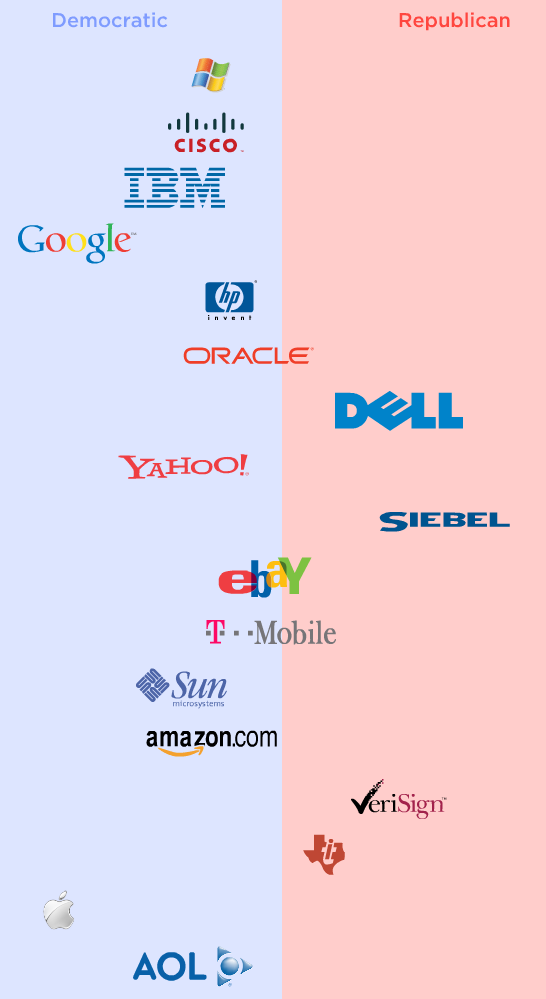Political Leanings of the Tech Industry


For years I’ve heard Gifford Pinchot talk about the HappoDammo ratio, so it’s nice to see him finally put it into written words:
I realized that we had had a very happy afternoon and done a tiny fraction of the environmental damage done by a typical afternoon of golf followed by a dip in the club pool. No bulldozers were used to make the Linnaea course. No trees were cut down; no sand hauled in; no pesticides, herbicides or fungicides or irrigation were used. I guessed that we had achieved at least the same level of happiness with less than one thousandth of the environmental damage.
Thanks to archive.org, I was able to find this seven year old blog post of mine. I had just attended the Planetwork conference in San Francisco, a combination social media – social responsibility conference.
In my blog post from June of 2003, I found this gem:
I signed up for LinkedIn, another hot topic at the conference. LinkedIn, like Friendly Favors is a social networking site, that allows us to utilize the relationships we already have. For example, let’s say that you know I know Peter Theony, author of TWiki. And you would like to make a proposal to Peter, but you also want to make sure he’ll give it due consideration. So you ask me to give you an introduction to Peter, or to forward your proposal to him, and putting in a good word for you. Well, this is exactly what LinkedIn does, except that it does it automatically, and allows us to utilize relationships that you don’t know about (like my unusual connection to Weekly World News). Conference reports suggest they are about four weeks into a viral explosion.
It’s funny to consider that we really had to explain what it was, or people just didn’t get it.
I also wrote:
I met Rebecca Blood, author of The Weblog Handbook. We had an interesting conversation on the social effects of macroeconomics (amazing what you can talk about as an MBA student). We also talked about my WikiAdoption experiences at HP.
That chance conversation led to a panel presentation on wikis at SXSW in 2004.
Here’s a great article by Malcolm Gladwell on How David Beats Goliath. A fascinating look at how effort and unconvential strategy – questioning the rules and assumptions – can lead to incredible results.
When Vivek Ranadivé decided to coach his daughter Anjali’s basketball team, he settled on two principles. The first was that he would never raise his voice. This was National Junior Basketball—the Little League of basketball. The team was made up mostly of twelve-year-olds, and twelve-year-olds, he knew from experience, did not respond well to shouting. He would conduct business on the basketball court, he decided, the same way he conducted business at his software firm. He would speak calmly and softly, and convince the girls of the wisdom of his approach with appeals to reason and common sense.The second principle was more important. Ranadivé was puzzled by the way Americans played basketball. He is from Mumbai. He grew up with cricket and soccer. He would never forget the first time he saw a basketball game. He thought it was mindless. Team A would score and then immediately retreat to its own end of the court. Team B would inbound the ball and dribble it into Team A’s end, where Team A was patiently waiting. Then the process would reverse itself. A basketball court was ninety-four feet long. But most of the time a team defended only about twenty-four feet of that, conceding the other seventy feet. Occasionally, teams would play a full-court press—that is, they would contest their opponent’s attempt to advance the ball up the court. But they would do it for only a few minutes at a time. It was as if there were a kind of conspiracy in the basketball world about the way the game ought to be played, and Ranadivé thought that that conspiracy had the effect of widening the gap between good teams and weak teams. Good teams, after all, had players who were tall and could dribble and shoot well; they could crisply execute their carefully prepared plays in their opponent’s end. Why, then, did weak teams play in a way that made it easy for good teams to do the very things that made them so good?